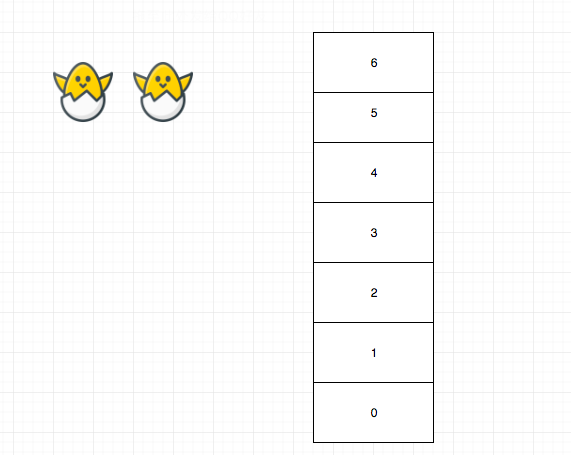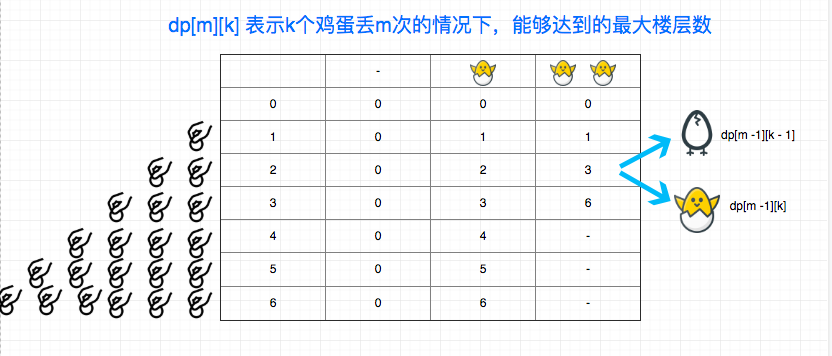题目地址
https://leetcode.com/problems/super-egg-drop/description/
题目描述
You are given K eggs, and you have access to a building with N floors from 1 to N.
Each egg is identical in function, and if an egg breaks, you cannot drop it again.
You know that there exists a floor F with 0 <= F <= N such that any egg dropped at a floor higher than F will break, and any egg dropped at or below floor F will not break.
Each move, you may take an egg (if you have an unbroken one) and drop it from any floor X (with 1 <= X <= N).
Your goal is to know with certainty what the value of F is.
What is the minimum number of moves that you need to know with certainty what F is, regardless of the initial value of F?
Example 1:
Input: K = 1, N = 2
Output: 2
Explanation:
Drop the egg from floor 1. If it breaks, we know with certainty that F = 0.
Otherwise, drop the egg from floor 2. If it breaks, we know with certainty that F = 1.
If it didn't break, then we know with certainty F = 2.
Hence, we needed 2 moves in the worst case to know what F is with certainty.
Example 2:
Input: K = 2, N = 6
Output: 3
Example 3:
Input: K = 3, N = 14
Output: 4
Note:
1 <= K <= 100
1 <= N <= 10000
思路
这是一道典型的动态规划题目,但是又和一般的动态规划不一样。
拿题目给的例子为例,两个鸡蛋,六层楼,我们最少扔几次?
一个符合直觉的做法是,建立dp[i][j], 代表i个鸡蛋,j层楼最少扔几次,然后我们取dp[K][N]即可。
代码大概这样的:
const dp = Array(K + 1);
dp[0] = Array(N + 1).fill(0);
for (let i = 1; i < K + 1; i++) {
dp[i] = [0];
for (let j = 1; j < N + 1; j++) {
// 只有一个鸡蛋
if (i === 1) {
dp[i][j] = j;
continue;
}
// 只有一层楼
if (j === 1) {
dp[i][j] = 1;
continue;
}
// 每一层我们都模拟一遍
const all = [];
for (let k = 1; k < j + 1; k++) {
const brokenCount = dp[i - 1][k - 1]; // 如果碎了
const notBrokenCount = dp[i][j - k]; // 如果没碎
all.push(Math.max(brokenCount, notBrokenCount)); // 最坏的可能
}
dp[i][j] = Math.min(...all) + 1; // 最坏的集合中我们取最好的情况
}
}
return dp[K][N];
果不其然,当我提交的时候,超时了。 这个的时复杂度是很高的,可以看到,我们内层暴力的求解所有可能,然后 取最好的,这个过程非常耗时,大概是O(N^2 * K).
然后我看了一位leetcode网友的回答, 他的想法是dp[M][K]means that, given K eggs and M moves,what is the maximum number of floor that we can check.
我们按照他的思路重新建模:
可以看到右下角的部分根本就不需要计算,从而节省很多时间
关键点解析
- dp建模思路要发生变化, 即
dp[M][K]means that, given K eggs and M moves,what is the maximum number of floor that we can check.
代码
/*
* @lc app=leetcode id=887 lang=javascript
*
* [887] Super Egg Drop
*
* https://leetcode.com/problems/super-egg-drop/description/
*
* algorithms
* Hard (24.64%)
* Total Accepted: 6.2K
* Total Submissions: 24.9K
* Testcase Example: '1\n2'
*
* You are given K eggs, and you have access to a building with N floors from 1
* to N.
*
* Each egg is identical in function, and if an egg breaks, you cannot drop it
* again.
*
* You know that there exists a floor F with 0 <= F <= N such that any egg
* dropped at a floor higher than F will break, and any egg dropped at or below
* floor F will not break.
*
* Each move, you may take an egg (if you have an unbroken one) and drop it
* from any floor X (with 1 <= X <= N).
*
* Your goal is to know with certainty what the value of F is.
*
* What is the minimum number of moves that you need to know with certainty
* what F is, regardless of the initial value of F?
*
*
*
*
*
*
*
* Example 1:
*
*
* Input: K = 1, N = 2
* Output: 2
* Explanation:
* Drop the egg from floor 1. If it breaks, we know with certainty that F = 0.
* Otherwise, drop the egg from floor 2. If it breaks, we know with certainty
* that F = 1.
* If it didn't break, then we know with certainty F = 2.
* Hence, we needed 2 moves in the worst case to know what F is with
* certainty.
*
*
*
* Example 2:
*
*
* Input: K = 2, N = 6
* Output: 3
*
*
*
* Example 3:
*
*
* Input: K = 3, N = 14
* Output: 4
*
*
*
*
* Note:
*
*
* 1 <= K <= 100
* 1 <= N <= 10000
*
*
*
*
*
*/
/**
* @param {number} K
* @param {number} N
* @return {number}
*/
var superEggDrop = function(K, N) {
// 不选择dp[K][M]的原因是dp[M][K]可以简化操作
const dp = Array(N + 1).fill(0).map(_ => Array(K + 1).fill(0))
let m = 0;
while (dp[m][K] < N) {
m++;
for (let k = 1; k <= K; ++k)
dp[m][k] = dp[m - 1][k - 1] + 1 + dp[m - 1][k];
}
console.log(dp);
return m;
};
书籍推荐

